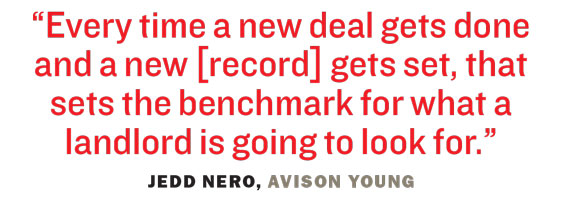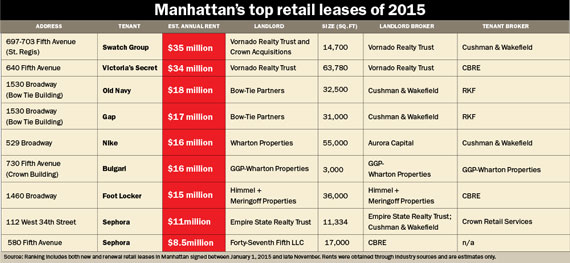For Victoria’s Secret, the journey to find a new flagship location in New York City took more than a decade.
But its patience seems to have paid off. In October, the company landed a lust-worthy new address: at Vornado’s 640 Fifth Avenue, near 51st Street. The multi-level 63,780-square-foot store is expected to open in November 2016.
The deal, which had an annual starting rent of $34 million, was the second most expensive retail lease in Manhattan of 2015, according to a ranking this month by The Real Deal. While retail rents are not publicly available, TRD pieced together the priciest deals by talking to sources involved in the transactions.
“It literally took 11 years to get this deal done,” said CBRE’s Richard Hodos, who represented Victoria’s Secret. “Some of these bigger deals take a longer time.”
Topping the list was a $35 million two-lease deal by the Swatch Group, which will take 14,700 square feet at the St. Regis Hotel’s retail condominium, owned by Vornado Realty Trust and Crown Acquisitions. It’s unclear how these two leases break down, and the brokers involved weren’t able to provide further details. The Swiss company is planning to have its subsidiary Harry Winston occupy the space. While Swatch has yet to announce which of its other brands will occupy the space, one possibility could be high-end watchmaker Breguet.
Other top deals of the year were Old Navy, Gap and Nike, which, respectively, locked in leases at $18 million, $17 million and $16 million for year one.
The leases signed by both Victoria’s Secret and Swatch represent a significant premium over last year’s most expensive Manhattan retail lease, Microsoft’s deal for a 22,270-square-foot flagship store on Fifth Avenue and 53rd Street that was valued at $17 million. In fact, only two leases in 2014 surpassed the $10 million marker: Microsoft’s deal and Top Shop’s lease at 608 Fifth Avenue, which had an estimated annual rent of $15 million.
Of course, any comparison of rents comes with some caveats.
 Hodos said considerable “financial engineering” is behind these major leases, in the form of rent or tax breaks or “millions and millions of dollars” in construction costs footed by the landlord. He said these lease perks often tell more about a deal than the total asking rent.
Hodos said considerable “financial engineering” is behind these major leases, in the form of rent or tax breaks or “millions and millions of dollars” in construction costs footed by the landlord. He said these lease perks often tell more about a deal than the total asking rent.
“Landlords are coming up with a lot of tenant allowances,” he said. “Sometimes what you don’t know is as important as what you do know.”
‘Athleisure fever’
Price escalation aside, the top retail deals of 2015 once again cement Fifth Avenue and Broadway as the two most valuable retail corridors in New York City.
They also underscore an ongoing retail trend: the rise of athletic-leisure brands. Whereas last year, tech and luxury stores dominated the top deals, this year both Footlocker and Nike inked deals for massive spaces on Broadway — Footlocker signed a $15 million deal to lease 36,000 square feet at 1460 Broadway and Nike sealed a $16 million deal for 55,000 square feet at 529 Broadway.
NPD Group, which tracks consumer behavior, reported earlier this year that “athleisure fever” remained strong in the first quarter of 2015, with an 8 percent increase in sneaker sales and a 9 percent jump in active-wear. Footlocker, for example, saw its net income rise to $119 million in the second quarter of 2015, a 29 percent increase year over year.
But the big lease deals of 2015 were not limited to companies with strong outlooks. In June, Gap Inc., which has been shuttering stores due to struggling sales, signed two leases at the Bow Tie building in the heart of Times Square. The retailer plans to divide 1514 Broadway, which is located at West 44th Street between Broadway and Seventh Avenue, into two stores for its parent brand, Gap, and lower-end label, Old Navy. The store is currently the home of Toys “R” Us, whose lease expires in 2016.
The Gap will take up 31,000 square feet— 6,000 square feet on the ground floor and 25,000 square feet on a lower level — as well as signage at the top of the Bow Tie Building. Old Navy will take 32,500 square feet and build an additional floor that will bring its total space up to just under 50,000 square feet, according to those familiar with the deal.
“They saw that the visibility and branding opportunity that this location provided to Times Square made it a unique opportunity for them,” said RKF’s Ariel Schuster, who represented Gap in the deal. He declined to discuss any details of the lease.
Faith Hope Consolo, chairman of retail leasing at Douglas Elliman, said the move to Times Square is one that will help resuscitate the company’s ailing brand.
“This is a big statement,” she said. “I think this will change how everyone thinks about them.”
Rent inflation
So how high exactly will retail rents go at the top of the market? According to several experts, they will eventually come back down to earth.
“I don’t think it can go any higher because tenants still need to make money,” said Cushman & Wakefield’s Joanne Podell, who represented Nike in its lease at 529 Broadway and Sephora in its $11 million agreement at 112 West 34th Street.
Nonetheless, some believe that precedents are important.
Deals like Bulgari’s $16 million lease renewal for a smaller space in the Crown Building at 730 Fifth Avenue could embolden landlords to test the limits, said Jedd Nero, principal at Avison Young. Rent for the 3,000-square-foot space works out to roughly $5,500 per square foot, a far cry from the average rents in the area, which are in the ballpark of $3,000 per square foot, according to Nero.
Despite its dizzying price, the lease nonetheless represents a significant downsizing. The luxury Italian jeweler and designer will give up all of its roughly 6,000 square feet of upper-level retail at the store. Noted architect and retail designer Peter Marino has been tapped to renovate its new space.
Perhaps more importantly, the deal, which extends Bulgari’s lease by another 15 years, ensures the brand’s continued presence on 57th and Fifth Avenue — one of the city’s most high-profile retail corners. The store is Bulgari’s only location in New York City.
“It sets the tone for what’s going on for Fifth Avenue,” Nero said. “Every time a new deal gets done and a new [record] gets set, that sets the benchmark for what a landlord is going to look for.”

